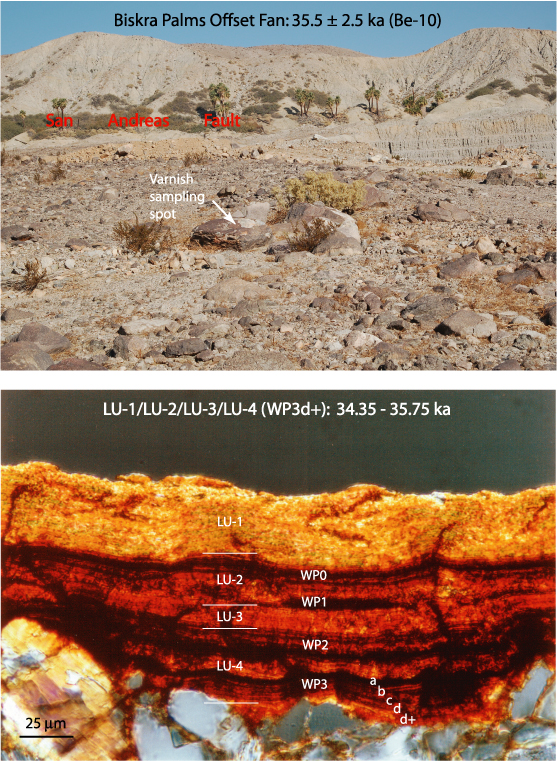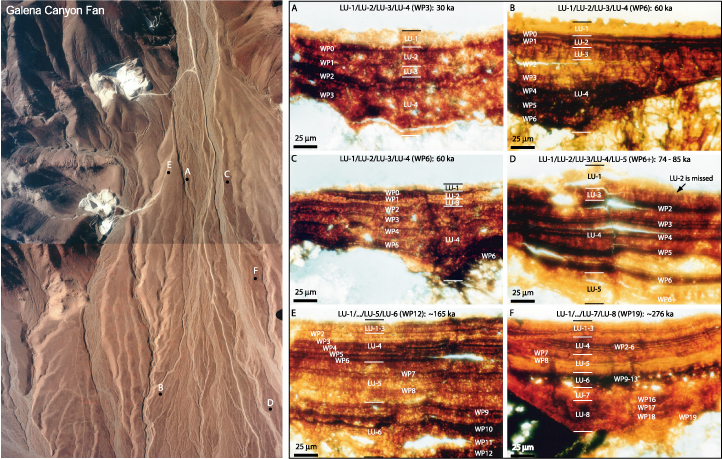

Figure Caption: A debris-flow fan (~ 0.04 km2 in size) on the east side of Death Valley, California (upper panel) and optical microstratigraphies of rock varnish from the debris-flow fan deposits (lower panel). Seven debris-flow fan units (Df1-Df7) were identified on the basis of fan morphology and degree of rock varnish coverage. Varnish-based age estimates indicate that these debris-flow fan units were deposited around 12500 (Df1), 12500-11100 (Df2), 11100 (Df3), 10300 (Df4), 9400 (Df5), and 2800 (Df6) cal yr BP (Liu and Broecker, 2006). The dating results also indicate that the deposition of these fan units was more likely to have occurred during relatively wet periods of the Holocene.

Figure Caption: Late Quaternary basaltic lava flows in Pisgah, Cima, and Amboy volcanic fields of the Mojave Desert, California (left panel) and optical microstratigraphies of rock varnish from these flow surfaces (right panel). Varnish-based age estimates indicate that the placement of these dated lava flows occurred around 24-30, 46-60 and 74-85 ka (Liu, 2003), which are in good agreement (within one sigma error) with cosmogenic Cl-36 dating results for the same flows (Phillips, 2003).

Figure Caption: Late Quaternary alluvial-fan surfaces offset by normal faulting events at the base of Hanaupah Canyon fan in Death Valley, California (left panel) and optical microstratigraphies of rock varnish from these geomorphic surfaces (right panel). Varnish-based age estimates indicate that a major faulting event (F1) occurred sometime between 30 and 12.5 ka, which offset the older Qf(LU-4) fan unit, and that a subsequent minor faulting event (F2) occurred after 12.5 ka, which offset the younger Qf(LU-2) fan unit.

Figure Caption: Late Holocene alluvial-fan surfaces offset by a recent faulting event on the Death Valley Fault Zone (DVFZ), about 1.25 km south of the Furnace Creek junction along California State Highway 178 (upper panel) and optical microstratigraphies of rock varnish from these geomorphic surfaces (lower panel). Varnish-based age estimates indicate that this faulting event occurred sometime between 1.4 ka and 0.9 ka, and most likely around 1.1 ka if a lag time of about 200 years is assumed for varnish initiation on the fault scarp (Liu and Broecker, 2006).


Figure Caption: High-resolution satellite image of a tectonically offset alluvial fan along the San Andreas fault near Indio Hills, southern California (upper panel) and VML age estimate (lower panel) for the abandonment of the offset fan surface (middle panel). The VML age estimate of 34.35 - 35.75 ka for the offset fan is based on a tentative correlation of millennial-scale wet events recorded in varnish microstratigraphy and cold events recorded in the GISP2 ice core record (please click here to see the climatic correlation). Note that such VML age estimate is nearly identical to the previously derived cosmogenic 10Be age of 35.5 ± 2.5 ka for the same offset fan (van der Woerd et al., 2006). Given an accumulative lateral displacement of 565 ± 80 m along the San Andreas fault (between two piercing points marked by two dark arrows; van der Woerd et al., 2006), this suggests a long-term slip rate of about 16 mm/yr along the fault.


Figure Caption: High-resolution satellite image of a tectonically offset alluvial fan along the Northern Death Valley fault in southern California (upper panel) and VML age estimate (lower panel) for the abandonment of the offset fan surface (middle panel). The VML age estimate of 68.95 ka for the offset fan is based on a tentative correlation of millennial-scale wet events recorded in varnish microstratigraphy and cold events recorded in the GISP2 ice core record (please click here to see the climatic correlation). Note that such VML age estimate is nearly identical to the previously derived cosmogenic 10Be age of 70 +22/-20 ka for the same offset fan (Frankel et al., 2007). Given an accumulative lateral displacement of 297 ± 9 m along the Northern Death Valley fault (between two piercing points marked by two dark arrows; Frankel et al., 2007), this suggests a long-term slip rate of about 4.3 mm/yr along the fault.

Figure Caption: Aerial photograph of Arizona Meteor Crater (upper panel; view NW), ground photograph of a giant ejecta on the east rim of the crater (middle panel; view NW), and optical microstratigraphy of rock varnish from this giant ejecta (lower panel). Varnish-based age estimate indicates that the impact of the Meteor Crater occurred around 46 ka or earlier, which agrees well with cosmogenic Cl-36 age of 49.7 ± 0.85 ka (Phillips et al., 1991).

Figure Caption: Varnished colluvial boulder deposits along the west flank of the Yucca Mountains, southern Nevada (upper panel; view E) and optical microstratigraphy of rock varnish from the colluvial boulder deposits (lower panel). Varnish-based age estimate indicates that the minimum-limiting age for emplacement of these deposits is about 46 ka.

Figure Caption: Vertical aerial photo of late Quaternary alluvial-fan surfaces of varying age at Galena Canyon, Death Valley (left panel) and VML age estimates for these fan surfaces (right panel). Note that the VML age estimates of ~165 ka and ~267 ka for varnish samples E and F, respectively, are based on presumed correlation of basal dark layers LU-6 (WP12) in E and LU-8 (WP19) in F with the cold episodes represented by δ18O isotopic events MIS 6.42 and MIS 8.4 in the SPECMAP record (Martinson et al., 1987).

Figure Caption: (A) A varnished grinding stone from Chili of northern New Mexico, where numerous Anasazi pottery shards were found. (B) Rock varnish from the grinding stone in (A) displays a latest Holocene layering sequence LU-1 (WH2), suggesting a varnish-based minimum age of 900-1100 cal yr BP for abandonment of this occupation site by the Anasazi Indians. (C) A varnished primary stone core from Ocotillo of soutern California (collected by Jay von Werlhof, Desert Museum of Imperial Valley College). (D) Rock varnish from the primary core in (C) displays a latest Pleistocene layering sequence LU-1/LU-2 (WP0), suggesting a varnish-based minimum age of 12500 cal yr BP for the making of this stone artifact by the Paleo-Indians. A camera cap in (A) is for scale; arrows in (A) and (C) point to sites where varnish-filled microbasins were cored with a mini-drill (4 mm in diameter) for dating. Please see Liu and Broecker (2006) for more information about application of VML dating in geoarchaeology.
 |
 |
Figure Caption: SPOT satellite imagery of alluvial fans in Death Valley, California (left panel) and Six Springs alluvial-fan units mapped with the use of varnish microstratigraphy as a regional correlation tool (right panel). Please see Liu and Dorn (1996) for more information about this mapping method.